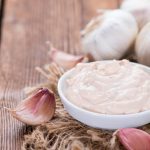
It came as no surprise to me to learn that mayonnaise was now vying with tomato ketchup for the top sauce spot with Britons. The two products constantly do battle for our tastebuds as the favourite dollop on beefburgers and chips, for salads and sushi, and its unrelenting. Back in 2016 mayonnaise even knocked ketchup off the top spot but they have made a comeback in recent years. I wasn’t surprised to hear either that vegan mayonnaise is starting to catch up on the carnivore’s version although labelling has to be an issue.
When you look at mayonnaise or mayo for brevity, it is seen by all of us as a thick, creamy, rather fatty sauce. The Belgians have adopted it as a signature sauce for pommes frites and it has gathered this national quality up with pace and then spread it to the rest of Europe. Many of us have both ketchup and mayo in a bowl or bottle where they grace the table with equal unprejudiced balance.
The traditional method of mayonnaise production is by blending at high speed egg yolk, water, edible oil, vinegar, salt, and other ingredients to form an oil-in-water (O/W) emulsion. The egg yolk is essential because it improves sensory perception and is needed for emulsion stability. Egg yolk does have health risks for those having high levels of cholesterol and saturated fats which could contribute toward obesity and chronic heart diseases. Vegan versions are now available and we touch on some of these in due course of this article.
History Behind Mayonnaise
It might be worth just stating where mayonnaise came from in the first place. The history behind it is quite interesting because there is quite a lot of confusion as to how it acquired its name. There are many stories but we can start with the one that has most credence. It was originally named for the city of Mahon which is the capital on the island of Menorca in the Mediterranean. Back then Menorca was a British run island because of its critically placed port which was a threat to the French in the Med.
In April of 1756, the Duke de Richelieu from France invaded Menorca to take the port of Mahon. An aioli bo sauce was created on the island which was the forerunner of mayo. This recipe was taken back to France and popularised by the said Duke at the French court. It was known then as mahonnaise because of its city origin. Over time the name has been derivatised and is now shortened in many circles to just mayo.
In all honesty, it is likely that sauces of mayonnaise type were being made in France and Spain using garlic a number of years before then. As far as records permit, the aioli as it is known would have been a very potent flavoured sauce using cream and egg with plenty of garlic for flavour and probably some vinegar to produce the correct consistency.
What is mayonnaise made of?
A good mayonnaise of the non-vegan variety is a condiment that contains oil, usually rapeseed or sunflower oil in Europe but often corn oil in the USA, some vinegar (5% acetic acid) to help with the flavour, a small amount of salt, some dry mustard for flavour and finally an emulsifier which happens to be egg yolk. The egg yolk is added because it contains plenty of lecithin (phosphatidylcholine) which is one of the best emulsifiers around.
A Classic Emulsion
Mayonnaise is a classic emulsion.
An emulsion is simply a combination of two immiscible liquids like oil and water which would not normally be combined but are mixed in a way to create a relatively stable liquid.
In most cases emulsification is done by adding one ingredient to the other with rapid mixing at the same time. The added liquid usually forms small droplets which are small enough to remain dispersed and suspended in the main liquid.
An emulsifier needs to be added to make sure the droplets do not coalesce. Emulsifiers like lecithin from egg yolk, sucrose esters and modified starches are used in the food industry for this purpose.
A typical commercial mayonnaise then is an oil in an aqueous system based on vinegar or lemon juice with egg yolk providing the emulsifier. The main method of production is to add the oil drop by drop into the mixture of vinegar with the added egg yolk. Rapid whisking provides the energy for mixing and keeping the droplets small enough so they keep dispersed.
The vegan variety has removed the egg yolk and replaced this with modified starch to obtain a similar emulsification effect. From what sensory testers claim there is not much difference between the non-vegan and vegan types save for a slight inconsistency in creamy texture. There have also been types using plant protein particulates to create Pickering emulsions.
Making A Good Quality Mayonnaise At Home
Building on what a typical mayonnaise happens to be, if you do not want a shop-bought mayonnaise that making a homemade version is ideal for all your favourite dishes. It’s also a good way of helping with an understanding of how simple this sauce is and how its made.
Ingredients:
- 2 egg yolks
- 1 tbsp Dijon mustard
- 250ml sunflower oil
- 2 tsp white wine vinegar or cider vinegar or lemon juice.
The egg yolks and mustard are seasoned with salt and pepper and then whisked vigorously to form the initial mixture.
Oil is added drop by drop with whisking so that the yolks combine effectively with the oil and a creamy emulsion forms followed by thickening.
If the mixture is thickening properly, more oil can be added a bit more at a time. If it is added too quickly then the mayonnaise splits and curdles. It can be rescued by adding more oil.
Having added all the oil into the egg mixture, add the vinegar or lemon juice to provide the taste. the drop in pH helps stabilization.
In its fresh state, the mayonnaise lasts for two days in the fridge. If you want the garlic mayonnaise version then try making aioli which is such a pungent but flavoursome alternative.
Stabilizing Mayonnaise
Most commercial manufacturers try the lightest pasteurisation possible because the main issue is salmonella coming in with the egg yolk.
The conventional process is to batch process the liquid egg yolk at 61ºC for 3.5 minutes.
Light mayonnaise products contain between 40 and 55% oil and tend to be some of the most unstable. They split and coalesce very readily. The lower fat content means there a less stable emulsion is created. To produce a stable, light mayonnaise with 55% oil means using combinations of egg yolk and high HLB sucrose esters which increase viscosity and decrease oil droplet size. A high homogenisation speed is needed of about 8000 rpm with a long emulsification time (5 minutes) to allow for the formation of a stable emulsion.
Labelling Mayonnaise
Mayonnaise by definition in the USA must contain at least 65 per cent by weight of oil. This level is lower however in reduced-fat and fat-free mayonnaises. There is a standard of identity law which also means that commercial mayonnaise can only use egg. Any other mayonnaise such as a vegan variety cannot use this name because of the confusion it creates. A reduced fat mayonnaise is not a real mayonnaise because it contains modified food starch, cellulose gel and other thickeners and emulsifiers.
The Brands
Unilever are the producers of Hellmann’s. They have claimed the second spot as top sauce with tomato ketchup from Kraft Heinz taking the top spot in the last few years.
Branded Versions Of Vegan Mayonnaise
A number of well known brands such as Heinze and Hellman’s now have vegan versions which they label as vegan mayo to avoid labelling issues. Both businesses have embarked on this because of the growing trends in vegan foods. The launches all tend to coincide with January when new resolutions usually lead to dietary changes. In this instance January is often known as veganuary for anyone embracing a truly vegan diet and ay of life.
Hellmann’s created three new flavours for 202o which are chipotle, baconnaise and garlic. Chiptole is a chili flavour which has grown in popularity in the last few years. The heat of this chilli seems to blend well with the creaminess of mayo. Garlic is better known to all us who have enjoyed the pungency of aioli with our chips lounging besides some Mediterranean beach.
Bacconaise is a novelty for 2020 although it seems to be enjoying some notoriety amongst officianados of beef burgers and chickenburgers. Apparently, Hellmann’s found that 84 per cent of us Brits self-identify with bacon. We love its salty flavour. Over a third of us eat cured meat in some form or other once a week and 64 per cent have it at least three times a week. Not surprising then bacon as a flavour is being flaunted in a vegan products. There is a finding that bacon is so tempting many omnivores refuse to embrace vegetarianism because the taste of bacon is so overwhelmingly popular. There is even some evidence from Nielsen market research that folks who had embraced veganism were sorely tempted back to a meat eating diet.



Lovely – great recipe to use if you want the animal version. I have tried soy milk at room temperature and then combined really slowly with lemon juice to stop it curdling. It really takes practice to make a vegan version and I have thought about using a small amount of vegan emulsifier to improve the texture over time. I’m always worried about what else is in shop bought vegan mayonnaise. I’m hoping you will do some vegan mayonnaise recipes because this would be really helpful. I live in a mixed household so holding the line between meat eaters and vegans is not easy I can tell you.